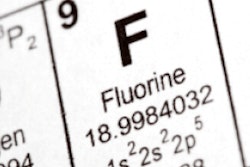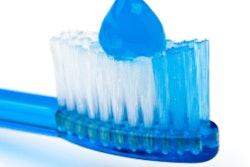
Various nonfluoride substances have shown promise for preventing caries in children's primary teeth. But a new research review has found that there isn't sufficient research yet to recommend that any of them take the place of fluoride for cavity prevention.
The researchers conducted a systematic review of studies on the use of arginine, casein phosphopeptide-amorphous calcium phosphate (CPP-ACP), chlorhexidine, triclosan, and xylitol for caries prevention in primary teeth. They found evidence that certain doses of xylitol may be effective, but results were inconclusive for the other substances.
"The current research evidence is not sufficient to confirm that the use of these nonfluoride agents is more effective than placebo or fluoride for preventing dental caries in primary dentition," they wrote (PLOS One, August 7, 2017).
The lead authors were Yu Wang of the preventive dentistry department and Jialing Li of the orthodontics department, both at the Medical School of Nanjing University in China.
Tough competition
Caries prevalence has decreased substantially in recent decades but is still of concern for high-risk individuals, including children. Around 30% of all caries occur in primary teeth, and nearly half of all children in the U.S. experience caries before attending kindergarten, according to previous research. Caries can develop more rapidly in primary teeth because of factors such as having thinner enamel compared with permanent teeth and the comparatively higher sugar consumption of children.
Caries development is believed to be a dynamic process of demineralization, which can be stopped through good oral hygiene or the use of chemical agents, including fluoride, xylitol, chlorhexidine, and CPP-ACP, noted the authors of the current study. The beneficial effects of fluoride have been shown, but the substance's dose-response relationship can lead to adverse effects such as fluorosis. The ability of nonfluoride agents to enhance or supplement the remineralizing effects of fluoride has been tested in studies, but their effect and safety are unclear.
The current systematic review was conducted to learn more on the topic. The researchers searched various scientific publication databases, such as Medline and Embase, and included so-called gray literature produced by researchers, such as studies in clinical trial databases. They sought randomized clinical trials conducted in humans that compared the effects on caries in primary teeth of nonfluoride agents compared with placebos or fluoride. They also examined the reported side effects of nonfluoride agents.
The review ultimately included 14 studies with a total of 4,269 participants ranging in age from 0 to 11 years old. Sample sizes ranged from 37 to 1,306, and study durations were three to 36 months. The nonfluoride agents studied were arginine, chlorhexidine, CPP-ACP, triclosan, and xylitol delivered as sugarless mint confection, paste, gel, varnish, snacks, tablets, and wipes.
| Study results on efficacy of nonfluoride substances | ||
| No. of studies | Topic | Results |
| 7 | Efficacy of chlorhexidine at preventing caries in primary dentition compared with other interventions |
|
| 3 | Anticaries effect of xylitol in the form of wipes, tablets, and snacks on caries progression in primary teeth |
|
| 2 | Comparison of daily application of CPP-ACP on dental caries in preschool children with fluoride varnish or placebo |
|
In addition to the studies listed in the table above, the authors identified one study on arginine and one study on 0.3% triclosan varnish that met the inclusion criteria. Topical arginine delivered as a mint confection reduced caries development after six and 12 months compared with placebo in one study, and the other study found 0.3% triclosan varnish was more effective than blank control at reducing caries incidence in children ages 2 to 5 years over one year of follow-up.
Seven studies found chlorhexidine had caries-reducing potential in primary teeth. However, one study found that it did not increase caries prevention when combined with low-dose fluoride compared with low-dose fluoride alone. Two studies found that chlorhexidine had a synergistic effect in combination with fluoride at controlling demineralization of primary teeth.
One study found that CPP-ACP mousse reduced white-spot lesions in anterior primary teeth and was associated with a smaller increase in the decayed, missing or filled teeth (DMFT) index compared with placebo or fluoride varnish. However, another study found that its daily use did not control early childhood caries better than low-fluoride toothpaste, and one study found that its use was not synergistic with fluoride toothpaste at preventing caries in primary teeth in preschool children.
“The current research evidence is not sufficient to confirm that the use of these nonfluoride agents is more effective than placebo or fluoride for preventing dental caries.”
"The advantage of using CPP-ACP as the agent rather than fluoride, however, is still unclear," the authors wrote.
Although xylitol wipes were found effective at controlling caries in primary teeth, no such effect was found with low doses of xylitol in 0.5- to 1.0-gram tablets. Additionally, the daily intake of xylitol gummy bears was not found beneficial beyond regular oral hygiene.
The conflicting results with xylitol could have been because of its dose-effect relationship and a low dose being used in one study, according to the authors. Additionally, conclusions were limited due to the small sample sizes of the included studies.
Only some of the studies reported on side effects. Among those that did, no serious side effects were found over 24 months with the use of chlorhexidine varnish or gel. No adverse effects were reported with 10% CPP-ACP paste, xylitol wipes, or xylitol-containing gummy bears.
Overall, the authors concluded that xylitol wipes are a useful adjunct for caries control in young children, but they advised caution regarding this finding due to the small sample size of the one study that reported this. In addition, chlorhexidine and CPP-ACP may be more effective than placebo at managing caries in primary teeth, but it's unclear whether they have advantages compared with fluoride, they reported. Although studies found that arginine-containing mint confection and 0.3% triclosan varnish reduced caries development in primary teeth, the results had a high risk of bias, they noted.
Leveling up needed
This systematic review was limited because the general quality of the included studies was not high, according to the authors. They assessed one study as having a low risk of bias and the remaining 13 as having either an unclear or high risk of bias.
Another limitation was the lack of reporting of side effects by some studies, they noted. The authors recommended that future studies should incorporate the use of randomization, blinding, and safety assessments, and they should go beyond the traditional methods of detecting and monitoring caries that were used in the studies to also include electronic diagnosis methods.
"High-quality randomized controlled trials are needed to make a definite contribution," they concluded.



















